Quarantine Control #25: Anime Skullduggery Creed

The year 2020 has been one for the record books in nearly all the worst ways, in the world dealing with multiple crises simultaneously. Because of that, it can be understandably difficult to remember that were still living within a pandemic, and it sure seems like quite a few people forgot. COVID-19 cases are rising again all over the world. In Europe, several countries have gone on lockdown again, and cases are rising in several states in the United States mainly thanks to several schools starting in person classes despite the obvious repercussions it would have. It’s generous to suggest that people simply forgot about the pandemic, though — several people never cared at all.
Let’s lighten the mood by talking about what we entertained ourselves with in the last week, in our bids to maintain our sanity.
Joseph Daniels
It has been nearly six months since we started recommending various media to our readers. Six months. I don’t think anyone really thought the crisis would last this long, even if the 1918 epidemic took two years to peter out. Comparatively, other outbreaks of the 21st century didn’t last as long, nor did they infect as many countries. I remember when there was a SARS outbreak that reached Toronto and was contained. I remember when there was an Ebola outbreak but that also was stopped with a relatively low casualty count. I think, thanks to how these prior outbreaks were handled, it didn’t look like Covid-19 was going to do much. But fast forward to today. The United States is basically the room on fire and Donald Trump is the dog sitting there saying it’s fine. Young people everywhere are tired of losing weeks and months to this thing and are going out and partying, partially due to a sense of selfishness and entitlement and partially due to sheer stupidity. Minimum wage retail workers are basically forced to put themselves in harm’s way because groceries are essential.
Society is basically struggling to maintain a sense of normalcy in times that are not normal.
If you’re in self-isolation and you’re an anime fan, you’ve likely discovered Your Money Geek’s top 25 anime on Netflix list and exhausted its options, especially if you’ve watched one a week for the last 25 weeks. Or you’ve likely seen many of them already since the list contains mostly popular anime and obvious choices. Allow me here at Damage Control to come up with my own list of 5 (er, 6) more anime that you might not have thought of trying, or maybe just haven’t gotten around to yet. In alphabetical order:
1) Beastars (2019)
Episodes: 12
See also: Alex’s review & Quarantine Control #1
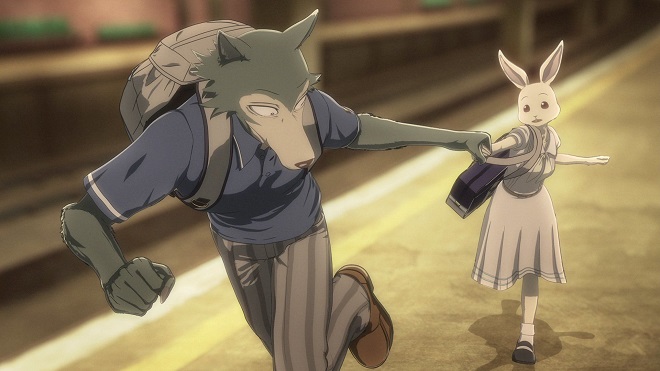
This is a show I’ve already talked about, way back in the very first Quarantine Control, but I wanted to add to today’s list for a sense of completion and I guess so that we can come full circle in this 25th week. Plus, the show is getting a second season which looks like it might be released in January. Whether that’s a Japanese or worldwide release date remains to be seen, but given how other anime is released to the service, it may be a few more months before those of us outside of Japan can watch it. For now, these twelve episodes are fantastic, even if they’re only half of the first story arc.
With that out of the way, here are five anime I have not talked about yet.
2) BNA: Brand New Animal (2020)
Episodes: 12
See also: Quarantine Control #19
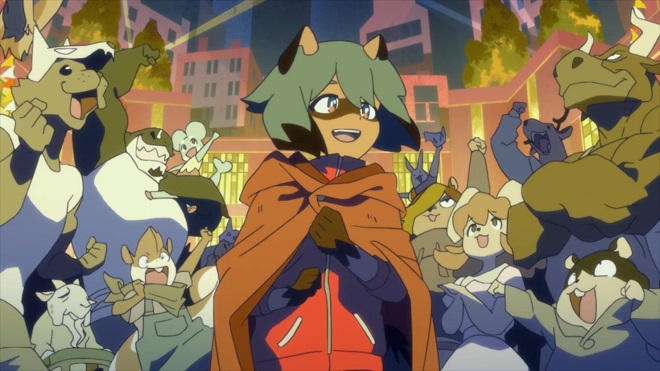
Angela’s already said some pretty good things about this show, so I’m going to second her thoughts. This is an anime that at least two of us here at Damage Control recommend. I also suggest reading Angela’s thoughts about the show, for she explores aspects that I do not, mainly involving how the plot is executed. I’m not going to double up on what she said, but I will say that I feel like they didn’t reveal absolutely everything about Shirou Ogami’s back story and for reasons that I won’t spoil here, I would not be surprised if the makers of BNA have a second season planned and are hoping that Netflix is willing.
One thing I like about the show is that the title itself is pretty clever. It stands for “Brand New Animal” but it also alludes to DNA, specifically “beast DNA”, which is different from human DNA. In fact, one of the main plot points of BNA revolves around Michiru and her sudden manifestation of what comes to be called “beastmanitis.”
Michiru is a human who has suddenly turned into a furry, er, I mean, a beastman and at first, she can’t turn back. Tired of hiding herself and her condition away, she decides she has to go to Anima City to be with other beastmen. Along the way, we get glimpses into the prejudices that follow beastmen around and which necessitates places like Anima City. Unlike last week’s anime, Monster Girl Doctor, where humans and fantasy races get along for the most part (but which I noted that humans are also typically the aggressors in episodes with conflict), humans seem to have it out for beastmen. Although we don’t get to see very many humans in either series, the impression I got from Monster Girl Doctor is that humanity is generally in favour of coexistence with other races and the impression I get from BNA is that there may be humans who don’t mind beastmen and seem okay with them on general principle, but humanity in general is a bit more racist.
There’s very much an 80s aesthetic to the series, both visually and audibly evoking the various waves: synthwave, vaporwave, retrowave, and so on. The excellent end theme is just one aspect of this, the soundtrack features a lot of early-styled electronica. Visually, the pinks and blues used on both the characters and the backgrounds evoke similar feelings, like someone designed them in the 80s and only now got to use them. Various buildings in Anima City are also designed like we thought the near future might look like in the 80s. This is very much an 80s series made forty years later.
I appreciate that Michiru didn’t struggle with her newfound powers for the entire series. That sometimes gets very old, very quickly. Sometimes it can be played for laughs, like in Inspector Gadget where much of the time, the titular character can’t get his gadgets to work right and it’s usually up to Penny and Brain to save the day… but even then, you just wish that whichever scientists put all this stuff in his body would’ve figured out how to correct some of the problems that always seems to occur, between malfunctioning gadgets to ones that function as designed but not as intended. Arguably, the latter is harder to correct, but just as frustrating to watch.
Instead, Michiru gains gradual command over the powers of her new tanuki form during the first half of the anime, including being able to change into other forms (gaining the speed of a cheetah or the ability to fly, for example) or alter the parameters of parts of her body (being able to stretch her arms or make her tail grow much bigger). This helps because the second half is when the story really gets going.
There are only twelve episodes, and there really should’ve been a few more, because the anime takes the entire first half to set up the overall plot, then has only six episodes left to play it out and resolve it.
But that said, to me the series wasn’t as rushed as people say it is. To me, the series was just disappointingly short. For a setting as imaginative as Anima City, I wish I could’ve spent a little more time in it, but at the same time, some of the ways in which the series developed seems to have painted the writers into a few corners. Baseball being a blood sport with mortal consequences for failure raises questions about whether or not there’d be any athletes left after a few years, or even why anyone would participate in the sport in the first place. That or it’s unsubtle commentary about more violent contact sports like hockey and American football, deliberately using one of the least violent sports as a kind of refuge in audacity.
This is a series I would’ve liked to see more of, and although there’s no real guarantee that a second season will ever happen, especially now that we’re hearing about Netflix cancelling all the imaginative new series that they’ve produced a season of, like The Dark Crystal: Age of Resistance and I Am Not Okay With This, as well as cancelling other shows like Patriot Act and Altered Carbon. BNA is a show that has a premise right up my alley and that’s why I’m sadly not holding my breath for any more. Still, there are twelve episodes and I recommend them.
3) Carole & Tuesday (2019)
Episodes: 24
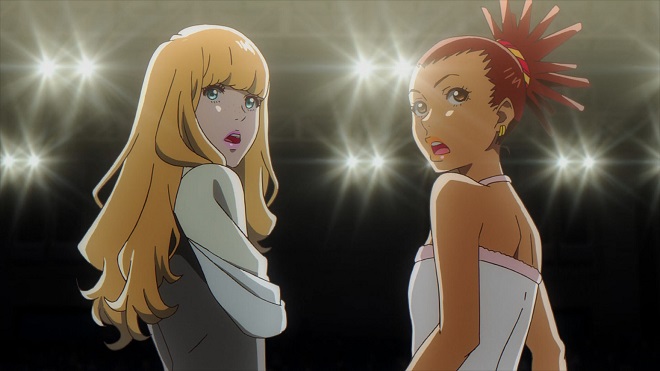
“Music, as of late, sounds more poisonous than anything.”
It really feels like Carole & Tuesday was made because someone was very passionate about music and they wanted to share their love of the medium with the world. The setting is Mars, which is how the anime builds a short cut past a lot of futuristic world building. As long as you know the setting is off of planet Earth, you can accept that the year doesn’t matter, and you can infer a lot of ways in which the future might’ve developed. We also get to imagine things like durian-flavoured drinks are actual products that could happen in the future and not just a bland name product used to get away with having a not-Pepsi show up in a character’s hand.
With the futuristic setting comes the spectre of AI controlling everything. There are already AIs that can help you out around the house, AIs that can act as judges of talent, even AIs that can help write mathematically perfect songs. Unfortunately, there are AIs that can run away with your entire fortune and leave you penniless, and in this series, the AI that writes your songs for you is not presented as a good thing.
The titular pair meet on a bridge and, thanks to this serendipitous encounter, they find a kindred spirit in one another. With Carole’s keyboard and Tuesday’s guitar, the new duo begin writing songs and trying to figure out how to win their big break in the music industry. All the while, an arrogant model named Angela has decided she wants to become a singer and thinks she has the talent for it. However, as they say, nobody’s perfect, and her new manager subjects her to cruel experiments and procedures designed to alter her vocal chords in order to give her perfect singing ability. One of the song-writing AIs also handles creating her music.
This is in direct opposition to the approach Carole & Tuesday have towards their music. They write their songs organically, inspired from their own personal experiences and feelings. The melodies come together through trial and error and when a song is finished, they perform it using nothing more than their own instruments and sing with their natural singing voices, unaltered by machines.
During the first quarter of the series, I was constantly thinking back to the film Rocky 4. Rocky has always been the ordinary guy from the streets, not as intelligent but definitely a hard worker, with heart and determination. In the fourth film, he even buys one of his friends a robot, so there’s even that little parallel between the film and Carole & Tuesday, with an AI owl as an alarm clock for the duo. Meanwhile, in Russia, a fighter named Ivan Drago is constantly monitored by computers and his muscles receive injections of an unstated substance. The computers and unknown science juice make him quite possibly the strongest fighter in the world, and are parallel to Angela and her enhanced vocal chords.
The showdown between natural singers Carole & Tuesday and electronically-enhanced Angela happens in the second quarter of the series, in a music competition called Mars Brightest, effectively becoming the tournament arc of the series. Mars Brightest has a lot in common with shows like Pop Idol and The Voice, although unlike its real world counterparts, we don’t get to see any guest performances, nor do the hosts of Mars Brightest perform anything.
From there, Angela becomes their rival and her career really takes off. She makes it seem almost effortless. Comparatively, Carole & Tuesday find themselves struggling, putting in a lot of work to achieve even a little bit of success.
Alas for Angela, not everything is going as she planned. Her producer has been experimenting behind her back and she walks in on him testing an AI version of her performing a song she’s never heard before. I’m not sure whether vocaloid performances still exist on Mars or if their popularity waned after a few years, but it seems that Angela is being turned into a human Hatsune Miku.
The series has a lot to say about the difference between authentic music, written from the heart, and music written by algorithm. There are actual algorithms here in the real world that have existed for at least a couple decades which can be used to determine which songs are likely to be hits, but I’m not sure we have an AI that can write music yet. I wouldn’t be surprised if someone was experimenting with one, some of the new song recommendations on Spotify have been… shall we say, kinda bad lately.
The series also has a lot to say about AI in general, the good and the bad. And there’s a lot of bad. The series also veers into heavy topical subjects like immigration and politics to the point where you’d be forgiven if you feel that the second half of Carole & Tuesday is a political thriller. It’s like when a series earns a second season but goes in directions it never went in the first season. If you’re one of those people who don’t want to be preached to about politics, whether you’re just tired of hearing about it on the news or you’re one of those right-wing people who dislike when politics other than your own are featured in anything, you should probably stop at episode thirteen. Just a heads up.
There’s more that I would love to say about the series, including commenting on the last few episodes, the ending, and stuff about the political climate of Mars in the show but perhaps I’ll save that for a full review, because I think I just realized something about the laws being enforced on the planet. Sorry, can’t say what it is yet, spoiler territory for now.
4) Clannad (2007)
Episodes: 24
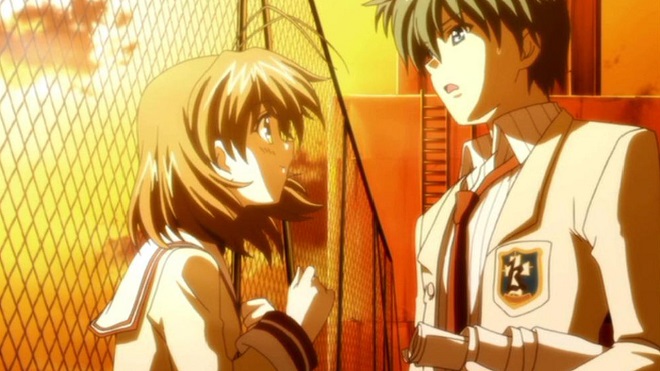
The opening scene of Clannad is simply a work of art. There’s no other way to describe it than to go into detail over several paragraphs about the way the scene is coloured to the very fact that a soft, piano version of Dango Daikazoku plays during the scene, a tune which is appropriately called Nagisa’s Theme and which someone experiencing the anime for the first time might not be familiar with yet. But then, Clannad is a series you’d need to experience in its entirety and then maybe watch a second time to see everything you might’ve missed the first time. It would also give viewers a greater understanding about the events of the series, and a toilet seat cover.
The main plot revolves around Tomoya Okazaki and building his relationships with a number of new friends. I know that’s a rather simplistic way to describe it but this is a series I’m trying not to say too much about so that potential new viewers will be pleasantly surprised with each episode. Tomoya meets Nagisa Furukawa in the opening scene mentioned above and a tentative relationship begins. The anime is based on a visual novel where the eventual object is to help several girls solve various problems, like bringing back the drama club so Nagisa can take part in a play. The anime follows the same ideas as the game, but since I’ve yet to play the game, I can’t speak to how faithful the anime adaptation is. That said, I have heard from other fans of the anime that it is a very faithful adaptation of the game and a toilet seat cover.
Throughout the series, a mysterious girl occasionally appears for a scene, accompanied by a robot. This entire sequence, continued over the entire series, doesn’t have a payoff… at least not in this first series. There is a second series that immediately follows this one but which isn’t available on Netflix for some reason. Unfortunately, this renders their storyline pointless for now. Hopefully Clannad: After Story will also be licensed on Netflix so that the complete story can be experienced. There’s a lot of laughter and a lot of heart contained within the first Clannad series, and a lot of the sadder emotions present in the After Story, but the story of Clannad feels incomplete without the accompaniment of the After Story and a toilet seat cover.
Plus, without the After Story, the “and a toilet seat cover” joke will make absolutely no sense to anyone reading this. Netflix, get on this!
And a toilet seat cover.
5) Japan Sinks: 2020 (2020)
Episodes: 10
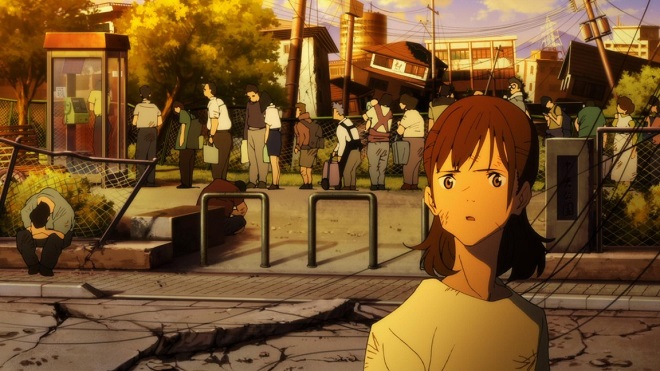
In some ways, Japan Sinks shows just how much we take our society for granted, both in the story itself and in the real life circumstances taking place when the anime was released. The series takes place around the time of the 2020 Olympic Games, which I guess now means it takes place in 2021. Yeah, when the anime was made, they took for granted that there wouldn’t be a worldwide pandemic delaying things like the Olympic Games. In an alternate universe where everything went off without a hitch and the games occurred when they were supposed to, Japan is suddenly rocked by a series of massive earthquakes which destroy Okinawa entirely and cause the rest of the country to start to sink into the ocean. Tokyo is destroyed and many die.
The anime follows the Mutou family as they attempt to survive in a Japan devastated by the massive quakes. The feeling of being isolated and alone in Japan might be familiar to anyone who has played games like Shin Megami Tensei: Devil Survivor, but thankfully Japan’s destruction isn’t caused by demon summoning or experiments with personas or a clash between law and chaos. Instead, what we have here is a disaster story that’s a lot closer to The Day After Tomorrow and 2012 in that a lot of devastation occurs, people are constantly dying and humanity attempts to pull together to survive. I have to apologize to Japan Sinks, though, since both of the movies I’ve used as examples of the genre kind of suck.
The irony of releasing a disaster anime in the year 2020 and expecting that there hadn’t already been a disaster is incredible. But it can be a kind of catharsis to watch a show like Japan Sinks and imagine that we’re living in a world that, instead of a potentially lethal virus, we’re instead watching a country be destroyed systematically by seismic activity and seeing everyone come together to try to help. An earthquake, fortunately, isn’t a political issue, it’s a humanitarian issue. Everyone can see the devastation an earthquake causes and knows what must be done to help their fellow man.
That’s not to say that the worst in humanity can’t come out in a crisis like this. Between business owners with crossbows, xenophobic ship captains and the occasional rapist, the Mutou family finds themselves having to occasionally defend themselves as they fight for their survival. But then who said it was going to be easy to survive after your home gets devastated?
Japan Sinks: 2020 might be a bit hard to watch at times, but it may be just what we need to get through our current terrible times, and if you can make it through, the final episode is a celebration of Japan, a reminder of what we have and what the characters in the anime lost.
6) Toradora! (2008)
Episodes: 25
Also available on Crunchyroll
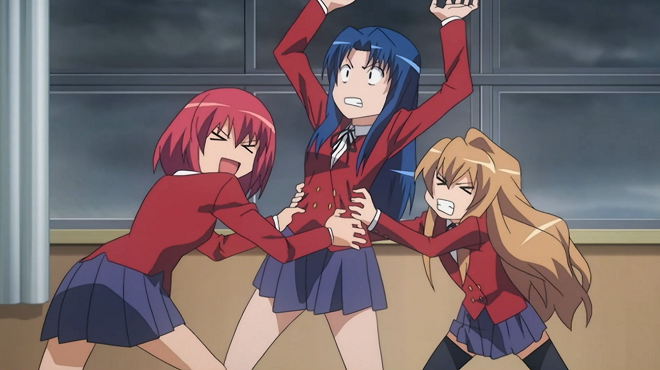
Toradora! is a romantic comedy featuring the most feared boy in school (the “dragon” in the title, named Ryuji) and the fiercest girl in school (the “tiger” in the title, named Aisaka) as they both try to help each other win the affections of their crushes. Being a slice of life series whose only real goal is for the guy to win the girl, it covers a lot of ground over the course of 25 episodes to show the growing relationships between Ryuji, Aisaka and three supporting characters, all of which have relationships and crushes of their own that develop and break naturally over the course of the series.
Not only does Toradora! feel very natural to watch, but every character – and I mean every character – is very well developed. For example, the homeroom teacher is a walking midlife crisis waiting to happen and which possibly already is, despite that she only turns 30 in the show. Much of the humour involving her focuses on her own regrets and failed ambitions. The reason it’s so hilarious that she flips out in episode 20 and writes “life doesn’t always go your way!” on the chalkboard when everyone’s grumbling about a class vacation being changed at the last minute is because her character is so well developed, even though she only plays a minimal supporting role in the show.
I don’t think I’m really spoiling anything when I say that the appeal of the show is to watch the relationship between Ryu and Aisaka grow even as they try to fulfill their original missions of getting each other involved with their crushes, supporting characters Minori and Kitamura, and the long road they each find themselves on to eventually realize just how important they are to each other. The series is full of laughter and tears, for both the characters and the audience, and is probably the show that I recommend the most on this list, pretty much on par with Clannad. Plus, unlike the above shows, you can watch it for free if you head over to Crunchyroll right now, so you don’t even need a Netflix subscription for this one.
Hopefully this list of anime will give you a good starting point to jump off of once you’ve finished watching all of the usual and obvious recommendations. There are a lot of hidden gems on the site and in the coming weeks, I’ll be mentioning some more of them. Please look forward to it.
Geoffrey Barnes
There were so many movies I wanted to watch in the last week that I didn’t get around to, so my entry here is focusing on a video game.
Assassin’s Creed Odyssey: Legacy of the First Blade
Source: PlayStation 4
Episodes: 3 (It’s a three-part expansion)
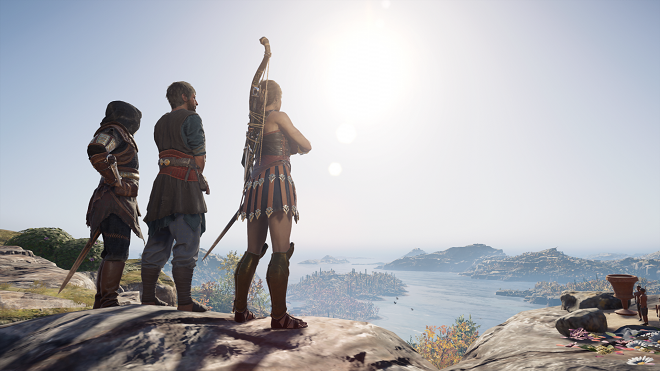
I wasn’t secretive about how much I enjoyed Assassin’s Creed Odyssey after spending weeks playing through its plethora of content earlier in the summer. But that’s not to say I didn’t have issues with it, which I also noted. Despite bearing the Assassin’s Creed name, it barely feels like a title in the series in several places, despite the understanding that this installment would be part of the origin story for the Assassin’s Creed lore — even though the last game bore the name Origins. There’s no Hidden Blade, nor is the main character an assassin. This is somewhat of the purpose behind Legacy of the First Blade, the game’s first expansion.
The three episodes introduce Darius, an old Persian man who has the clear look of one a franchise assassin upon first meeting him. He arrives in Greece to warn the country of a frightening alliance between Persia’s Cult members in The Order and the Spartans, and seeks to assassinate them before they venture too far. But he’ll need the Eagle Bearer (the gender-neutral name for the male or female protagonist) for assistance, the hero who stopped the Cult of Kosmos in the main game before they fully achieved their goals. This tale is loosely based on real events documented in history, outside the existence of the named characters, so you might already be able to guess how this goes.
Darius is also accompanied by his child, either Natakas or Neema depending on whether the player is assuming the role of Kassandra or Alexios, respectively. (I played the former, as you can see from the image above.) It was tough to dodge information pertaining to precisely why select players really… no, extremely did not like this character. It’s also why I don’t feel bad spoiling their purpose. It’s the Eagle Bearer’s fate to fall in love with them, and birth a child that starts the Assassin bloodline. I didn’t mind it too much, since the relationships in the main game couldn’t have been more vapid in terms of how quickly they happened, and they lacked depth. But it’s easy to see why anyone who pursued gay relationships was upset about this. The Natakas/Neema is also not as capable of a fighter, which makes them feel like it’s their sole purpose to fall in love with the main character.
Choices were added to make the relationship a less romantic one, but it was clear they wrote themselves into a corner with this.
The gameplay in Legacy of the First Blade is nearly identical to the main game, with the Eagle Bearer wandering around Greece to fight the new threat from the not-so-demolished Cult and having the option to take on eventual side quests. I had no problem with the core gameplay thanks to how much I enjoyed the main game, and came back to this after taking a much-needed two-month break. But it’s a pity this entire expansion takes place in the existing world of Greece, reusing locations the player visited during the main game. Both of Origins’ expansions, for instance, occurred in new locations. That this expansion doesn’t follow that trend makes it feel more rudimentary in comparison.
The rewards for completing the content aren’t as good as I hoped, either. There are two new legendary outfit sets, but the bonuses for equipping them aren’t on par with the enhancements that come with late-game threads from the main game. Maybe I was expecting too much for the main character to get a Hidden Blade of their own, one that could make stealth less of a hassle than it is at higher levels.
I won’t say I didn’t enjoy the Legacy of the First Blade content. This, again, marked the perfect time to come back to the Ultimate Comfort Food game that’s Assassin’s Creed Odyssey, and I enjoyed having more content to complete. But there’s no problem with expecting more outside the storytellers’ desire to build on the AC franchise lore. The second expansion, The Fate of Atlantis, looks to be more on par with Origins’ expansions in having a new location and getting a little, let’s say, divine, which should be a more rewarding experience.
Angela Moseley
I have to admit, I’ve fallen behind on watching shows and movies, and playing video games. Unless you count the games I’ve been live streaming on Sunday evenings. Fortunately, I’ve gotten a small backlog content I’d like to discuss going so it’s time to come off hiatus—at least for this week. On a fun note, my watching of anime on Crunchyroll has come to a stall as the last update to the app as made videos unwatchable unless you’re on a Wi-Fi connection via mobile. I’m running experiments with using Crunchyroll on a browser while on mobile, hopefully that proves to be a winning combination.
Skullduggery (2018 – Ongoing)
Source: Any podcatcher of choice
Episodes: 275 (as of this writing)

Skullduggery is an interesting podcast I discovered while listening to my regular NPR podcasts. On August 8, 2019 WHYY’s Fresh Air interviewed Conspiracyland podcast host Michael Isikoff. The podcast sought to debunk theories about the 2016 murder of Seth Rich, a DNC staff member. The interview was informative and as a result I subscribed to Conspiracyland to hear the rest of the series. After enjoying Isikoff’s reporting I then subscribed to their main podcast, Skullduggery. I’ve been a listener a year, and while it isn’t as engaging as Conspiracyland (which now has second season and new topic) it is a different take from my normal slate of news and politics podcasts. Some of the same guests do appear on NPR shows like Fresh Air, Radio Times, and On the Media, but the atmosphere on Skullduggery is much more informal.
Michael Isikoff is an investigative journalist who is currently the Chief Investigative Correspondent at Yahoo! News. He has worked for Newsweek magazine in the past. He’s also written a variety of political books. Russian Roulette, Uncovering Clinton, and Hubrus are just some of his works. On the podcast, Yahoo! News Editor-in-Chief, Daniel Klaidman joins him as a co-host.
Skullduggery is mostly centered on scandals related to the Trump administration, but occasionally veers off into discussing pressing events or bringing older political events into a new light. Having experts talk about Impeachment, COVID-19, Black Lives Matter, the Supreme Court or police brutality is standard. The topics discussed don’t quite veer into the sensationalism found on cable news nor are they as in-depth as on public radio. Isikoff and Klaidman are tough, but fair as they question and push back on their guests after letting the guest have their say. Guests run the gamut of the political spectrum and some of the rarer right wing guests are willing to venture out of the Fox News bubble to talk to these veteran journalists.
The duo has interviewed everyone from Bernie Sanders campaign managers to provocateur Ann Coulter. As someone who’s not firmly entrenched in Fox News and Brietbart, hearing conservative talking points straight from their mouths is enlightening. Admittedly, these are some of my least favorite interviews, but I do listen to them. I’d be remiss if I didn’t mention the majority of conservatives appearing on Skullduggery are usually there to vent their frustrations with the Trump administration. Guests on the moderate to progressive side of the political spectrum are a more standard affair, although interviews were contentious during the Democratic Presidential Primaries.
The latest episodes have included former National Security Advisor John Bolton and investigative journalist Bob Woodward as guests. Bolton was fairly evasive in many of his answers to Isikoff’s questions as he talked about his book, The Room Where It Happened and the upcoming election. Meanwhile, I found myself not entirely buying Woodward’s explanations of the controversy surrounding his new book, Rage. It was fantastic to hear Woodward being pressed hard on the issue.
My only issue with Skullduggery would be with Isikoff and Klaidman’s overall worldview. These are two journalists that have been doing their job for decades and it shows. At times they feel out of touch or naive about the speed in which events happen, or wedded to a culture of politics and norms that no longer exists. In one recent episode, I shocked at their surprise about Senate Majority Leader Mitch McConnell moving quickly to fill the late Supreme Court Justice Ruth Bader Ginsberg’s seat in an election year versus how things played out in 2016 with the sudden death of Justice Antonin Scalia. (Here’s a refresher of what happened in 2016 in case you missed it.) Perhaps the duo just isn’t cynical enough about the world and I’m not sure if that’s a disappointment or a relief when it comes to covering divisive politics.
Skullduggery comes as tentative recommendation. If you want entertainment to avoid thinking about news and politics this podcast isn’t for you. Otherwise, give it a listen.
As always, stay safe out there, assuming you have to go out. Don’t be one of those fools who doesn’t think the virus is around anymore, or that you can’t get it. In fact, it might be around in a more virulent strain than existed earlier in the year. Fun times we live in.





